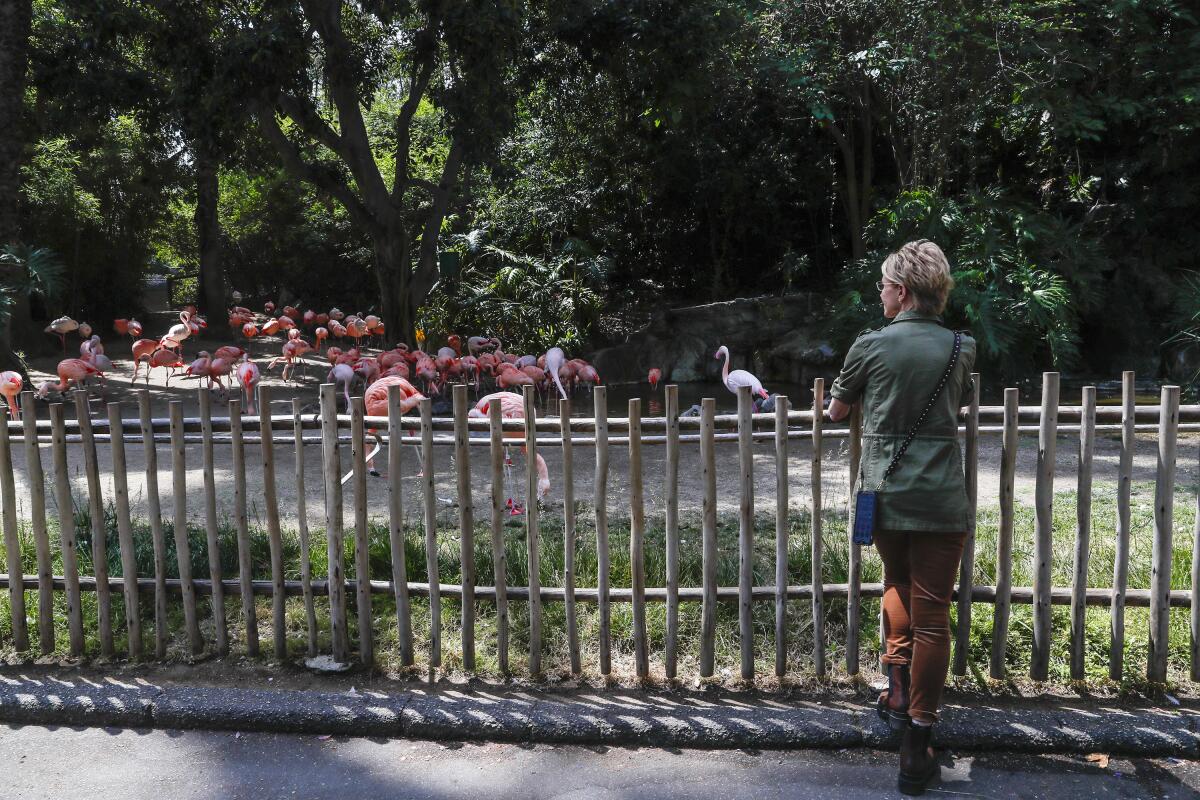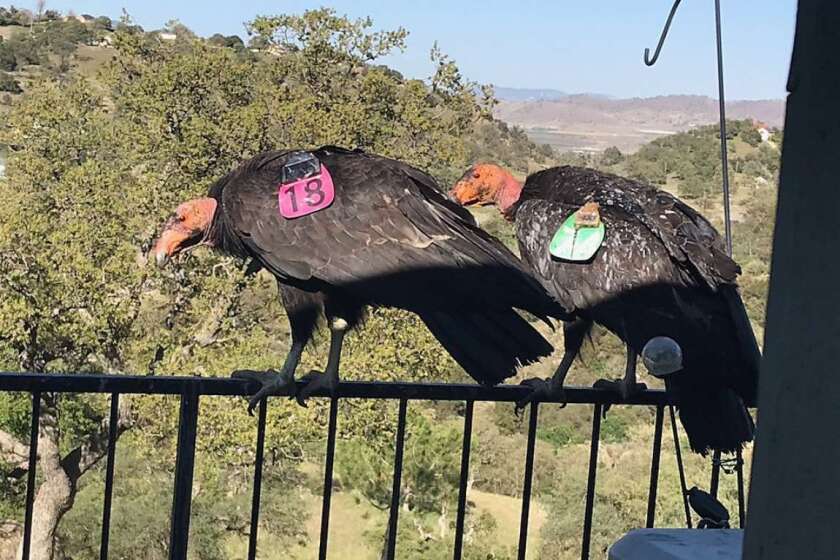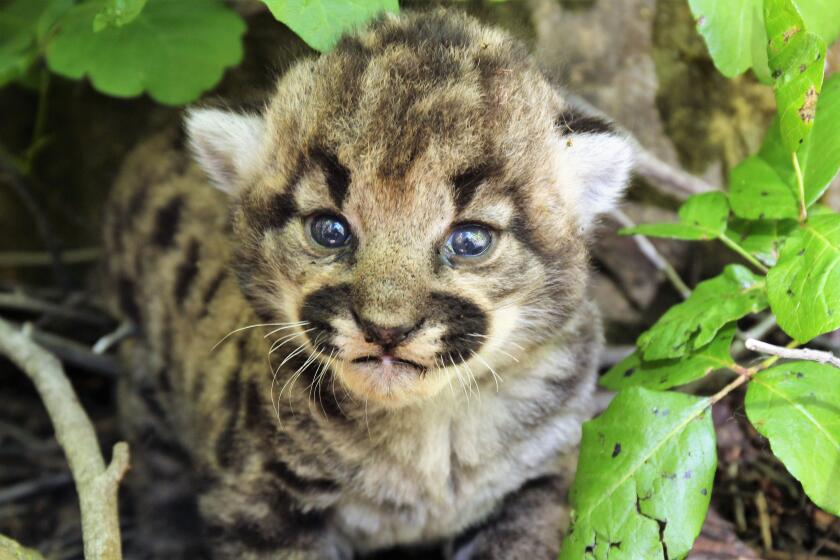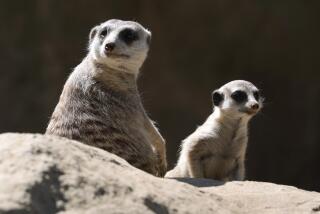Editorial: The L.A. Zoo’s plan to house mountain lions and grizzlies shouldn’t mean wrecking the view

- Share via
The Los Angeles Zoo envisions one day having mountain lions and grizzlies on display and possibly adding some California condors, North America’s largest land bird, which the zoo’s breeding program has helped save from extinction.
Those exhibits are ambitious ideas in the sweeping Los Angeles Zoo Vision Plan, which aims to rebuild many old, outdated exhibits and create new ones over 18 years. Some of those big ideas may not be feasible, but the zoo, which sits on 133 acres in Griffith Park, is smart to be planning its vision of the future now.
In the zoo’s latest plan, gone are the gimmicky aerial tram and vineyard that spurred so much controversy in a previous 2021 plan, which was decried as the zoo’s attempt to style itself as an amusement park.
The zoo also scotched plans to develop an area into an Africa-like savannah exhibit when environmentalists said that would destroy many natural and protected plants and trees. Instead, the zoo will embark on a major restoration of the flora in that area.
The good news is that after being on the brink of extinction, California condors now have enough numbers to gather for a party. The bad news is they’re messy.
Still, the zoo’s current vision plan (known as Alternative 1.5) has drawn criticism for proposing a man-made canyon and building a visitor center atop a ridgeline, potentially marring a spectacular view of surrounding mountains and trampling native vegetation, according to some environmentalists and Griffith Park advocates.
But there is much to like in this plan, and the zoo says it’s willing to make changes in response to concerns. When the City Council’s Neighborhoods and Community Enrichment Committee takes up the plan later this month, members should approve it.
Zoos need to build and renovate. At the same time, zoos — especially one in a park with native plantings and wildlife — need to be just as concerned about not harming the natural environment as any developer who wants to build in a park setting.
Critics are worried that the zoo’s planned California Visitor Center, which originally was described as a multistory Yosemite-like lodge sitting on the ridgeline, would be an eyesore and destroy native plants. The zoo has backed away from that plan, and said the new center would probably fit into the hillside or at least be less obtrusive on the ridgeline. But it would be better to just keep the facility off the ridgeline and preserve the unspoiled vista of mountain ranges and park.
As for the native plants there, few are rare, according to zoo conservation officials. This is not a pristine area. Consider what’s up there now: stored piping and other equipment, mulch and “zoo do” that goes into composting. Some native plants can be worked around and any native vegetation the zoo has to pull out for the project can be replaced.
Critics are also concerned that the zoo is considering creating a man-made canyon that would cut into the ridge. The canyon would be exhibit space as well as possibly a rock-climbing wall (to illustrate how keepers climb hillsides to check on condor nests in the wild). The zoo says the canyon is also to create an ADA-accessible and contiguous path around the zoo. However, in response to concerns that the canyon will be too destructive, zoo officials have decided to attempt tunneling into the hillside instead to create that pathway. That seems like the best plan.
P-77’s litter was found in a den in Simi Hills. What kind of life will these three pumas have if we don’t stop running them down on the roads and poisoning them with rodenticides?
The bigger parts of this plan involve building exhibits that are more spacious and modern. Some exhibits that became available after animals died or were transferred have been closed by the zoo because they were not large enough to accommodate animals or laid out efficiently for keepers. The habitat for the zoo’s two elderly lions who died in 2020 has not been occupied since. It’s too small for younger, energetic lions.
Additionally, the zoo will put in a 3.5-megawatt solar carport in its parking lot in an agreement with the Department of Water and Power that will be the largest solar project on city-owned land.
The zoo should always first and foremost focus on animal welfare and conservation. This plan will do that. But the zoo is also a community resource. Yes, there will be more special event space. The reality is that the zoo must make money to help pay for its staff, the care of the animals, conservation efforts and new exhibits. The first half of this project alone is expected to cost $650 million. (The City Council approving the plan does not obligate it to fund it. That’s a separate decision.)
The zoo should be a place to nurture and conserve wild animals, but it can also accommodate special events if done in a prudent and limited fashion. This proposed plan, with some tweaks, can set the zoo on a good path for the future.
More to Read
A cure for the common opinion
Get thought-provoking perspectives with our weekly newsletter.
You may occasionally receive promotional content from the Los Angeles Times.












